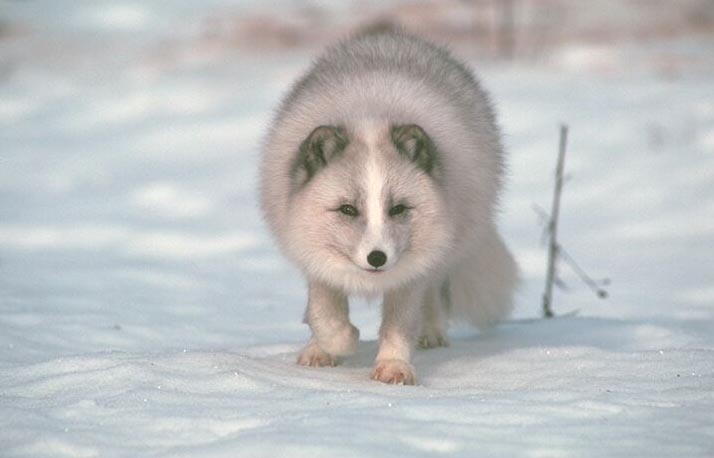Arctic Fox (Alopex lagopus) - Wiki Arctic fox
From Wikipedia, the free encyclopedia
The Arctic fox (Alopex lagopus), also known as the polar fox, is a small fox native to cold Arctic regions of the Northern Hemisphere. It is common in all three tundra biomes. Although some authorities have suggested placing it in the genus Vulpes, it has long been considered the sole member of the genus Alopex. The Arctic fox has smaller, more rounded ears, a more rounded braincase, and a slightly shorter and broader muzzle than the red fox, Vulpes vulpes (Clutton-Brock et al. 1976). Its feet are furrier than those of other foxes. The Arctic fox occurs in two distinct colour morphs, "blue" and "white". Each colour phase also changes seasonally: "blue" moults from chocolate brown in summer to lighter brown tinged with a blue sheen in winter, and "white" is almost pure white in winter, and in summer grey to brownish-grey dorsally, and light grey to white below. Colour morphs are determined genetically at a single locus, white being recessive. The "blue" morph comprises less than 1% of the population through most of its continental range, but this proportion increases westwards in Alaska, and on islands. In Greenland roughly half of Arctic foxes are of the blue morph, and in Iceland most of them are blue.
The Arctic fox has evolved to live in the most frigid extremes on the planet. Among its adaptations for cold survival are its deep, thick fur, a system of countercurrent heat exchange in the circulation of paws to keep them from freezing, and a good supply of body fat. The fox has a low surface-area-to-volume ratio as evidenced by its generally rounded body shape, short muzzle and legs, and short, thick ears. Since less of its surface area is exposed to the cold, less heat escapes the body.
Head-and-body length: 55 cm (21.7 in) (male); 53 cm (21 in) (female).
Tail length: 31 cm (12.2 in) (male); 30 cm (11.8 in) (female)
Shoulder height: 25-30 cm (9.9-11.8 in).
Weight: 3.8 kg (8.2 lb) (male); 3.1 kg (6.7 lb) (female).
Habits
The Arctic fox will generally eat any meat it can find, including lemmings, Arctic hares, birds and their eggs, and carrion. Lemmings are the most common prey. Arctic fox can also eat lemmings that they can't see beneath the snow. A family of foxes can eat dozens of lemmings each day. During April and May the Arctic fox also preys on ringed seal pups when the young animals are confined to a snow den and are relatively helpless. When its normal prey is scarce, the Arctic fox scavenges the leftovers of larger predators, such as polar bears, even though the bears' prey includes the Arctic fox itself.
Foxes tend to form monogamous pairs in the breeding season. Litters of between six and twelve pups are born in the early summer, a very large litter size for a mammal. The parents raise the young in a large den. Dens can be complex underground networks, housing many generations of foxes. Young from a previous year's litter may stay with the parents to help rear younger siblings.
The habitat of the Arctic fox spans coastal to inland tundra areas. The white morph is generally associated with true tundra habitat, the blue more with coastal habitat.
Population and distribution
The Arctic fox has a circumpolar range, meaning that it is found throughout the entire Arctic, including the outer edges of Greenland, Russia, Canada, Alaska, and Svalbard, as well as in sub-Arctic and alpine areas, such as Iceland and mainland alpine Scandinavia. The conservation status of the species is good, except for the Scandinavian mainland population. It is acutely endangered there, despite decades of legal protection from hunting and persecution. The total population estimate in all of Norway, Sweden and Finland is a mere 120 adult individuals.
The abundance of the Arctic fox species tends to fluctuate in a cycle along with the population of lemmings. Because the fox reproduces very quickly and often dies young, population levels are not seriously impacted by trapping. It has, nonetheless, been eradicated from many areas where humans are settled.
The Arctic fox is losing ground to the larger red fox. Historically, the gray wolf has kept red fox numbers down, but as the wolf has been hunted to near extinction, the red fox population has grown larger, and it has taken over the niche of top predator. In areas of northern Europe there are programs in place that allow hunting of the red fox in the Arctic fox's previous range.
http://en.wikipedia.org/wiki/Arctic_fox
| The text in this page is based on the copyrighted Wikipedia article shown in above URL. It is used under the GNU Free Documentation License. You may redistribute it, verbatim or modified, providing that you comply with the terms of the GFDL. |
